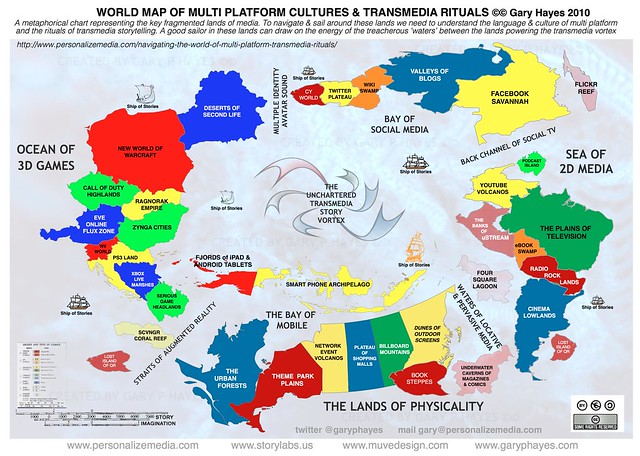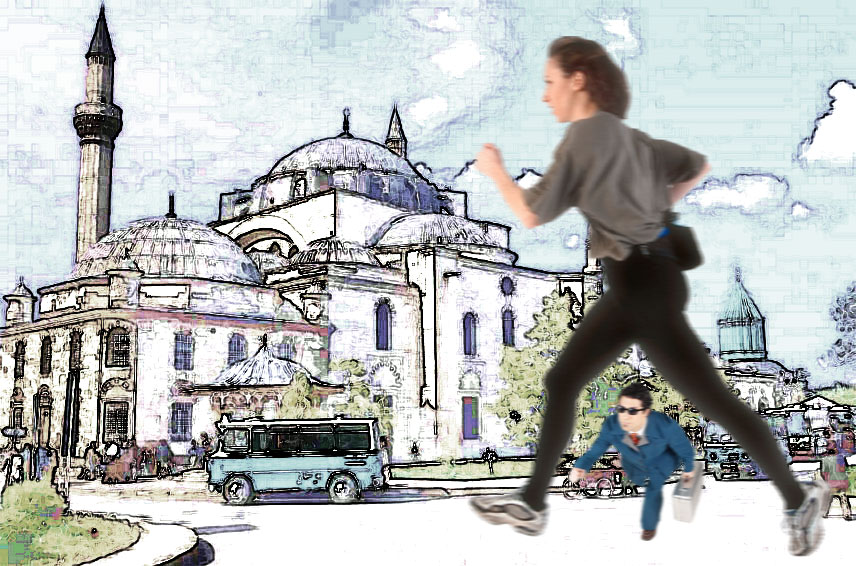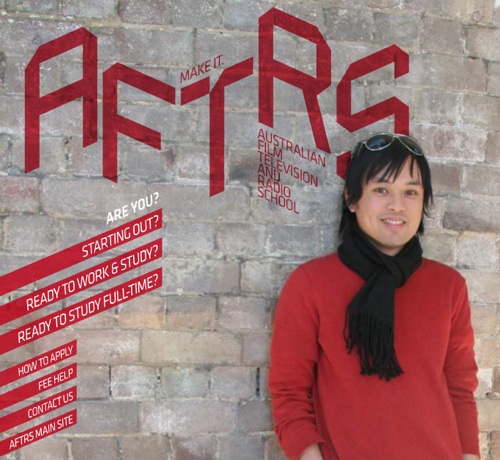I have been trying to find a really simple metaphor for clients, students and other industry professionals to help them better understand the complex world of multi-platform. Also completing the last few chapters of my Networked Media Storytelling book I needed a big but simple metaphor. One of the biggest issues I have faced over the years is rooted in the question “I tell stories on one or two platforms why do I need to reach out onto other platforms and how?”. I often reply with a long answer that falls into a few categories (1) Audience have fragmented 2) Business models have shifted (3) Engagement and social needs have altered (4) Have you noticed a general decline in traditional media? (5) Your stories can be improved exponentially if you ‘transmediarize’ them etc: I obviously leave the more fundamental ‘how to’s” to my consultations or workshops and a key element of that is what are the new platforms combined with how to design your story appropriately for them.
So for a few workshops & talks recently I developed a simple ‘graphic’ which demystifies some of the challenges storytellers face. This post describes the motivation and deeper thinking behind the World Map of Multi-Platform Cultures & Transmedia Rituals. How to understand this new world and how to navigate the relatively uncharted waters?
Ye Olde Days – The Disconnected World of Gated Platform
Around 40 years ago the opportunities for storytellers were both limited and segregated. By that I mean it was hard to truly make your media work across multiple distribution channels, sure you could do the whole film of the whole book or the whole radio play of the whole comic but the concept of placing ‘isolated’ narrative elements of your story appropriately designed for each and meant to ‘move’ users between them was a pretty alien concept. The more sophisticated story form within multi-platform (transmedia) was also hard to achieve due to the commercial gate holders on each platform wanting the ‘self-contained’ whole – not bits and pieces that also promoted competitors or drove traffic away.
But as we all know between 1990 and the present broadband internet, social media and mobile technology changed the landscape in a not so subtle way and old school media creative thinking is not relevant anymore in this altered landscape.
The New World Dis-Order of Multi-Platform Experiences
Wow how things have changed. Like our physical planet mass media and its internal cultures has splintered, the land masses moved apart leaving a complex environment to navigate.
Firstly we have the large continents of
- The Sea of 2D Media – Video, audio, images and includes the Bay of Social Media
- The Ocean of 3D Games – Social Worlds, Console single players, MMOGs, Serious, Casual
- The Lands of Physicality – Theme Parks, Outdoor Screens, Urban Spaces etc: and includes the Bay of Mobiles
Looking more closely at my map, consider the hybrid media ‘waters’ that separate the lands. Between Games and Physical Lands/Mobile we find the ‘Straits of Augmented Reality’ – meshing the digital and the real.
Between 2D Video and Social media we have the ‘Back Channel of Social TV’ and of course almost joined at the top of the multi-platform map, Social Media slowly becomes more 3D from right to left and moves into Social Games & Virtual Worlds across ‘indicative’ services such as CyWorld or Second Life or World of Warcraft. Please note that the territories listed here are ‘representatives’ of a specific ‘family’ of like-platforms and of course the map is not exhaustive.
This is a labyrinthine world and it’s complexity mainly comes from the vast range of incumbent or indigenous platform natives (loyal and super users?) in each territory. They have their own language, their own evolved culture, their own rules, rituals and value systems and to make things worse their own technical infrastructures – anyone got a universal plug adapter 🙂
There is a world (land/society) of difference between the main continents of 2D video media, 3D game, Physical Space (outdoor) and Social Media. Within each of those continents there are big cultural differences between each territory. In the Bay of Social Media a blog serves a completely different role to say, Facebook and over in 2D Video, uStream is an foreign country compared with cinema and in Lands of Physicality designing a game for an urban space is a million miles from writing a book or delivering to outdoor screens – you get the picture.
Cautionary Tale
One of the problems which started back in the days of mass media though, still pervades today. There is still a significant percentage of the ‘Digital’ industry that although they make noises about multi-platform integrated service design, still have a foot in 1970s thinking. They build their properties in each of the ‘territories’ where each build is the same as the last, and like invading hoardes they take what resources they can often by trying to be first come what may, ignore and in doing so kill off the indigenous culture in each territory and in some cases destroy all potential new media forms that were slowly evolving. Translation: A digital agency will produce a really badly designed service or reversion the non-appropriate stuff they already have on a new platform just to be one of the first kids on the block, but in doing so ruin it for those who may have followed with much more engaging new formats. Think what is happening to Video on the Web, Social Media Stories, Social Virtual Worlds, Locative Mobile and Augmented Reality for example as the advertising agency hoarde (amongst other invaders) crash on the shores and stick their flags in the virgin earth!
Navigating The Sometimes Treacherous Lands and Waters
So to get to the meat of this article – what is my map trying to evoke and how may it help story tellers navigate the waters of multi-platform and transmedia storytelling?
- TRANSMEDIA TOURIST – Firstly like any ad-venture you must take time to do initial visits to each territory and see if there are opportunities for yourself. At first don’t be frightened to be a tourist but make sure you ‘personally’ visit all these media territories – ideally with a guide. Travel the transmedia world, subscribe to some social media sites, play a few games, have a look around, stalk, take pictures, ask questions of the experienced natives, try to speak their language a little. But be a respectful tourist and do not rely on 3rd parties or ‘photo’ books or video diaries to make decisions on whether or not it is worth setting up and taking some of your story there – don’t listen to territorial spin!
- MULTI-PLATFORM CULTURAL UNDERSTANDING – Be appropriate with whatever your offering in these new territories. After a few visits you will start to get a sense of what the cultural values are and how your ‘story/product/extension’ may be relevant to both the medium and your overall distributed narrative. Beware of being a bully-like invader, delivering out of context messages – you will be branded as an unwanted spammer. Expect not to get your VISA renewed in this case!
- THE ISLANDS IN-BETWEEN – Often the waters in-between the continents are where you can be most innovative. Take time to explore these rocky unstable, hybrid media outposts. Consider them as volcanic activity pushing up new lands full of potential but also unclear on how the landscape will eventually pan out. Many of the waters around are treacherous so you really do need an expert guide to make sure you explore all the islands – social tv, augmented reality, location based services and so on.
- BUILT FOR LONG JOURNEYS – Make sure your story ships are filled with enough people and resources for the long haul. Circumnavigating around the central transmedia vortex, visiting and populating many media lands requires skill but also a stalwart determination to discover and tell your stories in appropriate places. Don’t assume you have to try to make camp everywhere – there are many who fail dramatically by spreading themselves thinly and in-appropriately, like a bragging tourist who are more into talking about how many vs how deep they went into each culture Making your stories take root in those lands requires careful delegation by having the right people on the ground running your operation in those territories. The culture also does not take it well if you promise much at the beginning and do not keep those promises – you appear on the scene, talk about all the great things you have planned and then go for the low hanging fruit, and leave. Shame on you!
- BECOME A TRAVEL AGENT YOURSELF– Once embedded in a territory and you story or property is captivating also from ‘the local platform users’ cultural perspective you can be certain they themselves will want to travel and pick up your transmedia tour. For example, consider some of the Zynga peoples who want to follow your brilliant and deep story world, help them hire boats and move over to 2D video lands and sail across into networking events in Lands of Physicality. They will reward you for this but make sure they never forget their story roots.
- TALK AND LISTEN TO THE NATIVES – Constantly monitor how you are doing in each media territory. Report back to your master ship, is the outpost working as part of the whole story tour you have created. As a travel agent you also have to keep the locals happy, has your story seed taken root? Is it part of the local mythology, are the locals themselves spreading the word? Your goal should be to become part of their culture rather than a fly-by-night alien visitor and also to constantly evolve your extended properties.
- RITUALS AND ROUTES – As a creator of a story route through the multi-platform world you are a pioneer, not many have truly ventured and created good transmedia tours yet. A few have tried to create trade routes but once the locals got wind of that, carnage resulted (I hope some of these metaphors are not lost!). Your initial tours will start to become well trodden (sailed) and a story that started in the Valley of Blogs moved over to Serious Game Headlands, to the Fjords of Tablets, over to Flickr Reef, then to the Deserts of Second Life and so on, will be travelled by many. Have you allowed those that take your tour to leave their mark, recommend, add in their own stories, extend yours. Make the journey be as important, if not more so, as the ports your travelers will stop at. The transmedia rituals involve a trip that is a important as the destination and stories that organically evolve and spread to new territories fueled by the users enthusiasm.
- LEAVING HOME CONVERTING THE NATIVES – As the users themselves become hyper-experienced multi-platform travelers they will loose sight of what they call home. Once a dedicated natives of for example, only the Volcano’s of YouTube, they have had their eyes opened to the possibility of the small islands of Qik and uStream, realized that the Lagoons of Foursquare fulfill new needs and desires. At this point you are turning mono media users into transmedia travelers, multi-linguists who they themselves start to travel and tell their own travel stories, creating their own story tours across the increasingly busy waters surrounding the uncharted transmedia story vortex.
I apologise for getting stuck in the metaphorical mud, but I wanted to get beyond some of the simplication and digital dumbing down that surrounds multi-platform at the moment. Finally something a bit more down to earth 🙂 A recent keynote presentation –
Note: As this was mostly written in airports and cafes – I will tidy this article up over the next couple of days also!
PRESENTATION – Fragments of Attention: Transmedia Alchemy
I gave a simplified version of the above combined with a quick overview of key multi-platform types and transmedia examples in New Zealand yesterday and I promised them I would ‘slideshare’ it. So here is it with embed below.
A short talk that looks at recent evolution of multi platform and changing user behaviour. It will highlight the reason traditional storytellers, marketeers and service providers are, for their own survival, needing to develop new transmedia forms. What are some of the most compelling examples thus far, is there really a business here and where are we truly headed? Gary will take us on a short ride through a fragmented media landscape and some of the transmedia attempts to help glue it back together again.
Link to Envisage presentation
“The popular Envisage series brought to you by CoLab in partnership with FILM AUCKLAND is back this year beginning in March 2011. Our fifth Envisage Program will focus on new developments and opportunities in Transmedia Production and Design with transmedia pioneers Fiona Milburn, Anna Jackson and keynote speaker Gary Hayes. From Sydney, Gary produces and lectures transmedia, virtual worlds, machinima, social media entertainment, augmented reality and marketing.”






rt @aaronisarun: Navigating the World of Multi-Platform & Transmedia Rituals bit.ly/lMg8tp – more interesting than it sounds
Love "The New World Dis-Order of Multi-Platform Experiences" map: bit.ly/jxPBws
RT @TopsyRT: Navigating the World of Multi-Platform & Transmedia Rituals | PERSONALIZE MEDIA bit.ly/jxPBws
Navigating the World of Multi-Platform & Transmedia Rituals #mustread me.lt/2w0Ak
No mundo Transmídia e Multiplataforma o Brasil seria o lugar das Planícies da TV tinyurl.com/69lwmwg
Navigating the World of Multi-Platform & #Transmedia Rituals linkd.in/mJx6Nm
Navigating the World of Multi-Platform & Transmedia Rituals | PERSONALIZE MEDIA bit.ly/gRwyMJ
Navigating the World of Multi-Platform & Transmedia Rituals | PERSONALIZE MEDIA bit.ly/gRwyMJ
Excellent: Navigating the World of Multi-Platform & Transmedia Rituals bit.ly/ocNjfm #transmedia #cartographie #map
Excellent: Navigating the World of Multi-Platform & Transmedia Rituals bit.ly/ocNjfm #transmedia #cartographie #map
Navigating the World of Multi-Platform & Transmedia Rituals | PERSONALIZE MEDIA lnkd.in/h5KpEz
Simple perspectives that I have used for about a dozen years may help orient your clients–
Stories are ‘made’ by the audience rather than the ‘storyteller’ or content curator or transporter.
Digital spaces are defined by software design and heavily influenced by database developers.
Interactions in digital spaces are negotiated based on measure and behaviour perspectives.
It is also helpful to consider to dis-entangle stories, people and spaces or that people may not differentiate between different ‘story’ spaces or places as they go about their day.
Cheers,
Nick @ResonantView @Groups_Groups
RT @garyphayes: Navigating the World of Multi-Platform & Transmedia Rituals t.co/hYRsuMNC
Navigating the World of Multi-Platform & #Transmedia Rituals t.co/11QnW0b5 Via @garyphayes
Schöner Artikel vor allem die Einführung des Kulturbegriffs gefällt mir: World of Multi-Platform & Transmedia Rituals t.co/pgZP66Xw
A good explanation of how to approach #transmedia as a newbie: t.co/RTA2Qnls t.co/JtlbD4B0
A good explanation of how to approach #transmedia as a newbie: t.co/RTA2Qnls t.co/JtlbD4B0
A good explanation of how to approach #transmedia as a newbie: t.co/RTA2Qnls t.co/JtlbD4B0
Le #storytelling à l'heure du #transmedia ouvre la voie à des #contenus hybrides… t.co/ZmVKxh1W
RT @garyphayes: Navigating the World of Multi-Platform & Transmedia Rituals t.co/64JVTAxd this may have saved my research! thanks!!!
RT @garyphayes: Navigating the World of Multi-Platform & Transmedia Rituals t.co/64JVTAxd this may have saved my research! thanks!!!
RT @garyphayes: Navigating the World of Multi-Platform & Transmedia Rituals t.co/64JVTAxd this may have saved my research! thanks!!!
RT @garyphayes: Navigating the World of Multi-Platform & Transmedia Rituals t.co/64JVTAxd this may have saved my research! thanks!!!
Navigating the World of Multi-Platform & Transmedia Rituals – t.co/p1gtNH9J
About the language and culture of multiplatform and the rituals of transmedia storytelling… t.co/1nWKIUwm by @GaryPHayes
RT @mogams: About the language and culture of multiplatform and the rituals of transmedia storytelling… t.co/zjOVFhLS by…
Navigating the World of Multi-Platform & Transmedia Rituals | PERSONALIZE MEDIA t.co/x4hLgiFY
Navigating the World of Multi-Platform & Transmedia Rituals | PERSONALIZE MEDIA t.co/x4hLgiFY
Archive: : Navigating the World of Multi-Platform & Transmedia Rituals t.co/cH104EMB
Archive: : Navigating the World of Multi-Platform & Transmedia Rituals t.co/cH104EMB
Navigating the World of Multi-Platform & Transmedia Rituals | PERSONALIZE MEDIA t.co/1WYCy97x via @@garyphayes
Archive: : Navigating the World of Multi-Platform & Transmedia Rituals t.co/cH104EMB
Archive: : Navigating the World of Multi-Platform & Transmedia Rituals t.co/cH104EMB
Great ideas! RT @GaryPHayes: Archive: : Navigating the World of Multi-Platform & Transmedia Rituals t.co/vcsOLdYy
Navigating the World of Multi-Platform & Transmedia Rituals t.co/lSDgD5zk via @prismatic
Archive: : Navigating the World of Multi-Platform & Transmedia Rituals t.co/cH104EMB